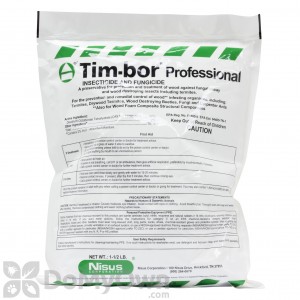What is Tim-bor?
Tim-bor is wood preservative that works as an insecticide and fungicide.
What is the active ingredient in Tim-bor?
The active ingredient in Timbor is disodium octaborate tetrahydrate a natural borate compound.
What is a borate compound?
Borate compounds are derived from mineral deposits that contain the element Boron. These compounds are use in the production of many products including ceramics, glass and medicines and also work extremely well as insecticides and fungicides.
Why is Tim-bor considered a insecticide and fungicide?
Insects are exposed to the active ingredient by eating treated wood or by ingestion while grooming. Borates are a contact toxicant to fungi. The borates prevent metablolism of food by insects and fungi causing death.
How is Tim-bor applied?
Tim-bor is applied the surface of bare wood as a liquid. It can also be applied as a dust into void attic and wall void areas for labeled insect control.
How does Tim-bor work as a wood preservative?
When Tim-bor is applied as a liquid to the surface of bare wood it diffuses into the wood to make the wood itself toxic to wood destroying organisms such as wood decay fungus or drywood termites.
Is Tim-bor concentrate a liquid?
Tim-bor comes in a powder form that is used as a powder or mixed with water to form a liquid solution. To create a 10% solution mixone pound of Tim-bor to one gallon of water. This solution must be applied twice to a bare wood surface. To create a 15% solutionmix 1.5 pounds of Tim-bor to one gallon of water. This solution can be applied only once to the wood surface.
Is Tim-bor labeled to treat wood decay fungus?
Tim-bor is labeled for the control and prevention of wood decay fungi including white rot, brown rot, poria and wet rots.
Is Tim-bor labeled for the control of carpenter ants?
Tim-bor is labeled for the control and prevention of carpenter ants by applying Tim-bor dust into active ant galleries and into areas where ants may enter the structure.
What wood destroying organisms is Tim-bor labeled to control?
Tim-bor is labeled for the control and prevention of drywood termites, wood destroying beetles, wood decay fungi, carpenter ants and termites.
Can Tim-bor be foamed?
Tim-bor can be foamed using equipment designed for foaming applications. Foaming requires a 15% solution in conjunction with a foaming agent. A dry foam is recommended for best results.
Does tim-bor effect ornamental plants?
Yes, over spray on plants or spills near the plant roots can kill or retard plant growth.
For all other information, specific mixing instructions, or general use directions, please read the product label.
Purchase Timbor
Related Product Pages:
Termite Control
Carpenter Ant Control
Related Articles:
Timbor
Termites and Termite Control Topics
Difference Between Termites and Carpenter Ants
How To Get Rid of Carpenter Ants
Wood-boring Bugs



